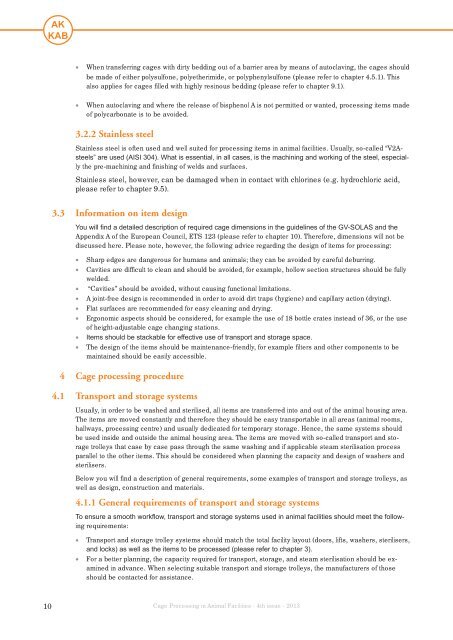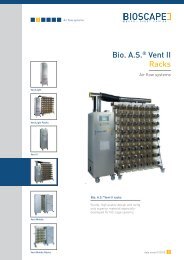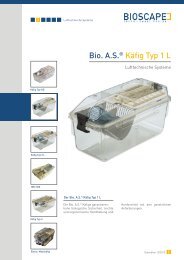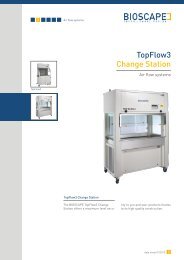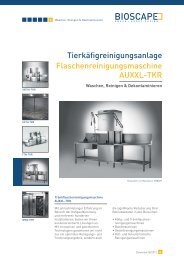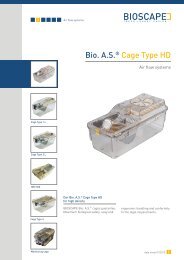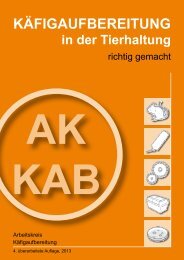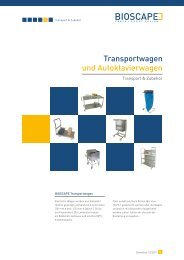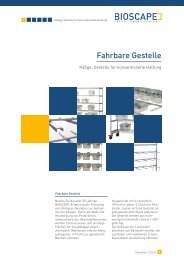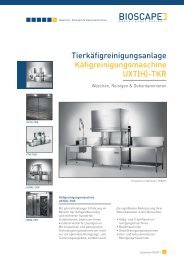CAGE PROCESSING in Animal Facilities - GV-SOLAS
CAGE PROCESSING in Animal Facilities - GV-SOLAS
CAGE PROCESSING in Animal Facilities - GV-SOLAS
You also want an ePaper? Increase the reach of your titles
YUMPU automatically turns print PDFs into web optimized ePapers that Google loves.
• When transferr<strong>in</strong>g cages with dirty bedd<strong>in</strong>g out of a barrier area by means of autoclav<strong>in</strong>g, the cages shouldbe made of either polysulfone, polyetherimide, or polyphenylsulfone (please refer to chapter 4.5.1). Thisalso applies for cages filled with highly res<strong>in</strong>ous bedd<strong>in</strong>g (please refer to chapter 9.1).• When autoclav<strong>in</strong>g and where the release of bisphenol A is not permitted or wanted, process<strong>in</strong>g items madeof polycarbonate is to be avoided.3.2.2 Sta<strong>in</strong>less steelSta<strong>in</strong>less steel is often used and well suited for process<strong>in</strong>g items <strong>in</strong> animal facilities. Usually, so-called “V2Asteels”are used (AISI 304). What is essential, <strong>in</strong> all cases, is the mach<strong>in</strong><strong>in</strong>g and work<strong>in</strong>g of the steel, especiallythe pre-mach<strong>in</strong><strong>in</strong>g and f<strong>in</strong>ish<strong>in</strong>g of welds and surfaces.Sta<strong>in</strong>less steel, however, can be damaged when <strong>in</strong> contact with chlor<strong>in</strong>es (e.g. hydrochloric acid,please refer to chapter 9.5).3.3 Information on item designYou will f<strong>in</strong>d a detailed description of required cage dimensions <strong>in</strong> the guidel<strong>in</strong>es of the <strong>GV</strong>-<strong>SOLAS</strong> and theAppendix A of the European Council, ETS 123 (please refer to chapter 10). Therefore, dimensions will not bediscussed here. Please note, however, the follow<strong>in</strong>g advice regard<strong>in</strong>g the design of items for process<strong>in</strong>g:• Sharp edges are dangerous for humans and animals; they can be avoided by careful deburr<strong>in</strong>g.• Cavities are difficult to clean and should be avoided, for example, hollow section structures should be fullywelded.• “Cavities” should be avoided, without caus<strong>in</strong>g functional limitations.• A jo<strong>in</strong>t-free design is recommended <strong>in</strong> order to avoid dirt traps (hygiene) and capillary action (dry<strong>in</strong>g).• Flat surfaces are recommended for easy clean<strong>in</strong>g and dry<strong>in</strong>g.• Ergonomic aspects should be considered, for example the use of 18 bottle crates <strong>in</strong>stead of 36, or the useof height-adjustable cage chang<strong>in</strong>g stations.• Items should be stackable for effective use of transport and storage space.• The design of the items should be ma<strong>in</strong>tenance-friendly, for example filters and other components to bema<strong>in</strong>ta<strong>in</strong>ed should be easily accessible.4 Cage process<strong>in</strong>g procedure4.1 Transport and storage systemsUsually, <strong>in</strong> order to be washed and sterilised, all items are transferred <strong>in</strong>to and out of the animal hous<strong>in</strong>g area.The items are moved constantly and therefore they should be easy transportable <strong>in</strong> all areas (animal rooms,hallways, process<strong>in</strong>g centre) and usually dedicated for temporary storage. Hence, the same systems shouldbe used <strong>in</strong>side and outside the animal hous<strong>in</strong>g area. The items are moved with so-called transport and storagetrolleys that case by case pass through the same wash<strong>in</strong>g and if applicable steam sterilisation processparallel to the other items. This should be considered when plann<strong>in</strong>g the capacity and design of washers andsterilisers.Below you will f<strong>in</strong>d a description of general requirements, some examples of transport and storage trolleys, aswell as design, construction and materials.4.1.1 General requirements of transport and storage systemsTo ensure a smooth workflow, transport and storage systems used <strong>in</strong> animal facilities should meet the follow<strong>in</strong>grequirements:• Transport and storage trolley systems should match the total facility layout (doors, lifts, washers, sterilisers,and locks) as well as the items to be processed (please refer to chapter 3).• For a better plann<strong>in</strong>g, the capacity required for transport, storage, and steam sterilisation should be exam<strong>in</strong>ed<strong>in</strong> advance. When select<strong>in</strong>g suitable transport and storage trolleys, the manufacturers of thoseshould be contacted for assistance.10Cage Process<strong>in</strong>g <strong>in</strong> <strong>Animal</strong> <strong>Facilities</strong> · 4th issue · 2013


